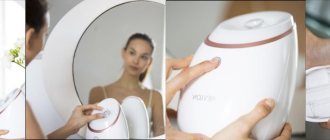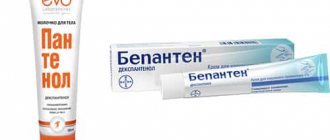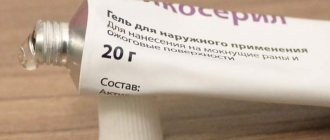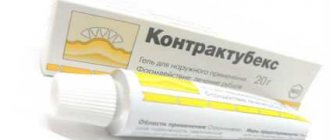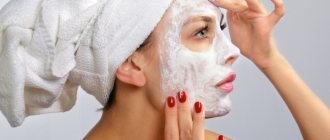Hello, dear readers! Today we'll talk about beauty. I think you care about how you look, and you've probably heard that retinol for facial skin allows you to prolong youth and beauty, which is what we women passionately desire.
If retinol appears on every Instagram page or is in all your friends' makeup bags, then the question arises: should you race to get it too? Is it really good for facial skin or are there any contraindications for use?
Let's listen to the experts who can help you figure out whether the trendy and controversial product is really what you need.
Let me make a reservation right away that the material was taken from a foreign publication, so perhaps those drugs that can be purchased there only with a prescription can be purchased from us without it.
General information
Retinol palmitate is a derivative of vitamin A and palmite salt. A fat-soluble substance that compensates for vitamin A deficiency in the body. The substance is not synthesized independently; it enters the body with food. The content in plant foods is lower than in animal foods. A shortage has serious consequences:
- premature aging of the skin, formation of wrinkles;
- the appearance of pimples, blackheads;
- increased susceptibility to infections;
- decreased reproduction;
- decreased functionality of the eye analyzer;
- increased fragility, hair loss;
- deterioration of tooth enamel;
- developmental delay in children.
Retinol based on palmite salt or ester is completely processed by the body. Unlike retinol acetate, synthesized using acetic acid. Manufacturers are different.
Retinol palmitate, oil solution 100000 IU/ml (10ml)
from 311 ₽
More details
| Active ingredient, name | Manufacturer, country |
| Retinola palmitate, retinol palmitate | ICN October, ICN October, Russia |
| Retinola palmitate, VitA-Pos | Ursapharm, Ursapharm Arzneimittel, Germany |
| Retinola palmitate, retinol palmitate | Marbiopharm, Marbiopharm, Russia |
Description and characteristics of retinol
Retinol is a retinoid and belongs to vitamin A derivatives. There are several forms available that differ in productivity.
Natural retinoids include:
- retinol acetate and retinol palmitate;
- retinaldehyde;
- retinol;
- tretinoin (retinoic acid).
The latter is considered the most effective form with a rejuvenating effect. If natural retinoids come into contact with the epidermis, they participate in chemical reactions and are converted into retinoic acid.
Retinol is required for:
- health of skin and hair;
- immunity;
- cell growth;
- inhibition of the processes of withering and aging.
Vitamin A deficiency is easily detected by peeling of the epidermis, increased dryness, dandruff, conjunctivitis, hair loss, decreased night vision, and susceptibility to infectious diseases.
A lot of retinol is found in foods: liver, fish, fruits and vegetables with orange and yellow colors (carrots, apricots, pumpkin). However, in order for retinol to be absorbed during digestion, fats are needed.
Retinol-rich foods
The instability and rapid destruction of retinol under the influence of oxygen and light determines its presence in cosmetics in such forms as:
- esters (retinol acetate/palmitate);
- retinaldehyde;
- true retinol.
The characteristic features of the compounds are differences in structure from the original vitamin, but complete similarity in principle of action and effectiveness.
Cosmetic preparations contain artificial retinoids, which are obtained in laboratory conditions. Lubrication of the epidermis is accompanied by their transformation into retinoic acid.
Creams containing retinoic acid are found in certain series of cosmetics.
Vitamin A and its forms used in home cosmetics have a mild but slow effect. This minimizes the threat of side effects. Effectiveness is noticeable only after 2 or 3 months of systematic use.
The initial use of Retinol is against acne and pimples in therapy and prevention. The drug activates the healing of skin wounds after cosmetic procedures.
According to scientific research, retinol smoothes the epidermis and improves elasticity. Daily use of the drug with this ingredient leads to the disappearance of fine wrinkles.
Attention! To improve the effect, retinol is combined with various substances. They give preference to drugs that are characterized by numerous positive responses and testing by specialists
Composition and release form
The most common is as an oil solution.
The photo shows what the packaging of drops used for oral administration of retinol palmitate drops looks like. Palmitate is available in the form of an eye ointment. Indicated for topical use for eye diseases. What the drug looks like can be seen in the photo. The vitamin is available in capsules or tablets. You can see what they look like in the photo. Each capsule contains an oil solution. The composition of the drugs can be seen in the table presented.
| Release form | Amount of vitamin A | Additional composition |
| Oil solution | 100,000 IU per 1 ml. One drop contains 3300 IU. | Rapeseed oil, butylated hydroxytoluene, butylated hydroxyanisole. |
| Ophthalmic ointment | 250 me in 1 gram. | Vaseline, liquid paraffin, lanolin. |
| Capsules | 100,000 IU per 0.1 ml capsule. | Corn oil, gelatin, glycerol, nipagin, water. |
Medications to combat facial wrinkles
Taufon
Active ingredient: Taurine. The amino acid normalizes metabolic processes in cells and regulates their functioning. To rejuvenate the facial covering, use Taufon for wiping twice a day (in the evening and in the morning). The course of treatment sessions consists of 7 procedures, repeated after 25 days.
Panthenol
Release forms: spray, ointment. Both forms are suitable for cosmetic manipulations. The product quickly regenerates diseased tissue, actively produces collagen, and resists the aging of cellular epithelium. Panthenol is just right for 50-year-old women. Use as a night cream or masks for rejuvenation several times a week.
Capsicam
Anti-inflammatory ointment accelerates cell division, used after 50 in the fight against wrinkles. It is not recommended to use the composition for a long period of time. Preferably in short courses, after 14-20 days.
Pharmaceutical preparations for rejuvenation
The following medications will help relieve swelling and inflammation around the eyes:
- Liquorice;
- Relief;
- Heparin ointment;
- Curiosin gel.
Pharmacological properties
The instructions for use of retinol palmitate preparations indicate the effect of oral administration.
Mechanism of action
In addition to replenishing the lack of vitamin A, it has a positive effect on:
- activation of redox cellular reactions;
- acceleration of cell division in the epithelial layers of the skin;
- prevention of keratinization of skin tissues above normal;
- provides energy for metabolic processes at the cellular level;
- strengthens the barrier role of cell membranes, which increases the body’s resistance to infectious diseases;
- a component of rhodopsin, which is responsible for twilight vision;
- enhances the hormonal activity of the adrenal glands;
- normalizes the functioning of sebaceous and sweat glands.
What happens after taking it
Retinol taken orally is completely absorbed in the intestinal tract. Most of it accumulates in the liver parenchyma. Lipocytes, specialized cells, are responsible for storage. In second place is the retina of the eye analyzer. It is present in small amounts in other organs. Excretion from the body occurs through bile, urine, and feces. It tends to accumulate due to the slow processing speed.
Cross-drug interactions
Retinol palmitate must be taken with caution, since the active substance can react with drug components. It should not be combined with Tetracycline, as this can provoke intracranial hypertension. In addition, we must remember that:
- Cholestyramine, Neomycin, Colestipol, as well as mineral oils reduce the absorption of retinol, which leads to an increase in its need.
- Oral contraceptives enhance the effect of vitamin A.
- Isotretinoin enhances the toxic effect of Retinol palmitate.
- High doses of vitamin E reduce retinol levels in the body.
Indications for use
The instructions for use indicate in what cases it is necessary to use retinol palmitate.
Pathologies of the visual analyzer
It is recommended to take medications both for the treatment of diseases caused by a lack of vitamin A, and for the complex treatment of diseases:
- dryness of the mucous membranes of the eyes;
- decreased vision at night;
- inflammation of the conjunctiva of the eye;
- dystrophic changes in the retina;
- progressive cataract;
- intense visual stress, wearing contact lenses, long periods of time at the computer;
- harmful effects of the environment - solar radiation, staying in a smoky room, under air conditioning.
Skin diseases
Vitamin A in the form of retinol palmitate is indicated for dryness, irritation, and lesions of the following nature:
- thermal effects on the skin;
- for ichthyosiform erythroderma - diseases in which large scales form in skin folds, hair, nails are characterized by accelerated growth;
- neurodermatitis - skin damage caused by allergic causes;
- keratoses - pathologies in which thickening of the epidermis occurs;
- psoriasis – scaly lichen, characterized by the formation of red spots that rise above the surface of the skin;
- acne, pimples on the face;
- excessive hair loss, baldness.
Pathological conditions of internal organs
The instructions stipulate the following cases when it is indicated to take supplements orally:
- ulcerative lesions of the gastrointestinal tract;
- infectious and colds of the upper respiratory tract.
Side effects
According to the instructions for Retinol Palmitate, in patients with excessive sensitivity to the components of the medication, it can provoke allergic reactions.
Sometimes, with prolonged use, jams and excessive dryness of the mucous membranes and skin appear. According to reviews of Retinol Palmitate, some patients also noticed increased skin sensitivity, which manifested itself even with minor touches. Typically, these signs do not cause significant discomfort and go away on their own with a lower dosage or temporary withdrawal from the drug.
In case of too long consumption of the vitamin by adults in an amount of more than 200,000 IU, and by children - 100,000 IU, hypervitaminosis or intoxication of the entire body is likely to occur. The symptoms of this phenomenon are as follows:
- gagging;
- painful sensations in joints and bones;
- nausea;
- migraine;
- lack of coordination;
- lethargy, loss of strength;
- drowsiness;
- facial hyperemia.
When treating acne, after a week there is likely to be an exacerbation of local inflammation, which in the future will stop on its own. This condition does not require additional treatment.
Contraindications and precautions
Vitamin A in the form of retinol palmitate should not be taken in the following cases:
- pregnant women in the first trimester due to negative effects on the fetus;
- during the acute phase of inflammatory pathologies of the skin;
- excess vitamin A in the body;
- chronic pancreatic disease;
- individual intolerance;
- gallstones.
Use caution, only on the recommendation of a doctor, for pathologies:
- viral hepatitis, cirrhosis;
- alcoholism, including those caused by beer abuse;
- heart failure;
- kidney inflammation;
- children and elderly people.
What is Retinol Palmitate
Retinol palmitate is a fat-soluble substance related to fortified preparations. The second, more well-known name is vitamin A. It is synthesized in the human body from beta-carotene, which comes with foods. In case of insufficient absorption from food, it is allowed to take medications containing vitamin A
The first discovery of retinol was made in 1913, at which time experiments were carried out proving the importance of the substance. Scientists have found that this component:
- helps regulate protein synthesis;
- needed for cell division and regeneration;
- strengthens the immune system;
- promotes the proper formation of bones and teeth;
- reduces the likelihood of developing skin diseases;
- sharpens vision;
- stimulates mental activity;
- serves to prevent heart diseases;
- improves spermatogenesis.
Features of dosage and methods of application
Vitamin A in the form of retinol palmitate is used as prescribed by a doctor; how many drops are needed for administration is calculated individually. Typically, supplements are taken once a day. It is recommended to take the drugs fifteen minutes after meals, late in the evening.
Supplements are prescribed in the form of drops:
- for the prevention and treatment of vitamin deficiency 33 thousand international units (10 drops);
- for the treatment of ophthalmological diseases from 50 to 100 thousand international units (0.5 -1.0 milliliter);
- for skin pathologies from 50,000 to 100,000 IU;
- therapy of acne, ichthyoform erythroderma - up to 300,000 IU.
An eye ointment containing retinol palmitate is placed under the lower eyelid. The strip is squeezed out to the size of one centimeter.
The vitamin in capsules is taken once a day, late in the evening, one tablet containing 100,000 IU.
Features of use for the face
Vitamin A is used in cosmetics for:
- getting rid of acne;
- obtaining a rejuvenating effect;
- reducing the number of fine wrinkles;
- alignment of the facial structure.
The substance is produced commercially in creams and masks. Retinol palmitate in the form of a solution is added to regular creams. There are known recipes for effective face masks made at home.
| Compound | Mode of application |
| Egg yolk, half a teaspoon of salt, 8 drops of retinol palmitate. | Mix and apply to face with a brush for three minutes. Used as a scrub. Effective against acne. |
| A tablespoon of cottage cheese and olive oil, 5 drops of vitamin A. | Prepare a homogeneous mixture, apply a layer of 2 millimeters for 20 minutes. |
| A teaspoon of dimexide, 50 grams of sour cream and white clay, 10 drops of vitamin. | Mix, apply a layer of five millimeters for 15 minutes. Effective against acne. |
Rules for using masks:
- It should be applied late in the evening, before bedtime - after the procedure, the skin is vulnerable to sunlight;
- applied to the face, neck, décolleté;
- up to 35 years of age, it is necessary to use retinol palmitate in the form of a solution, after that - in capsules;
- It is necessary to conduct an allergy test before use.
If anyone knows other recipes, please share your feedback.
Features of use for hair
Vitamin A is good for hair. Added to shampoos and masks. Application results:
- elasticity increases;
- shine increases;
- growth improves;
- the harmful effects of ultraviolet radiation are reduced;
- moisturizes the scalp.
A few milliliters are added to shampoos, and different recipes are used for masks.
| Compound | Mode of application |
| Dry collection of chamomile, nettle, horsetail, 10 grams each. Retinol – 4 capsules. Rye bread in the amount of 150 gr. | Prepare a decoction of herbs, leave for half an hour. Pour over bread, add capsules. The mass is rubbed into the roots and left for an hour under a cap. |
| Flax oil – 40 g., Eleutherococcus – 10 g., Retinol – 4 capsules. Egg yolk. | Mix the ingredients, apply to hair, distribute over the entire length. Leave for half an hour. |
To be effective, the mask should be used every other day.
Vitamin A is used to strengthen and grow eyelashes and eyebrows. The solution is applied to eyelashes and eyebrows with a small brush every night.
Features of use for pregnant and lactating women
How to take retinol palmitate preparations for pregnant women is decided by the gynecologist. The first trimester of pregnancy and breastfeeding are a contraindication . The rest of the time, women are recommended to have small maintenance doses of 5000 IU to avoid an overdose, which is more dangerous for the fetus than a deficiency.
Features of use for kidney pathologies
For nephritis, the use of the vitamin is not recommended. If an urgent need arises, how much supplement to take is decided by the attending physician, under the supervision of urine tests and biochemical blood parameters.
Features of use for liver pathologies
In case of viral hepatitis, cirrhosis, gallstones, the use of supplements must be agreed upon with a hepatologist.
Special conditions for children
Children under seven years of age should not be given vitamin A as a supplement. In conditions of vitamin deficiency, the pediatrician prescribes the use of the drug in a dosage of 5000 IU.
Elderly people
In old age, oral administration is dangerous; it is prescribed with caution, in a pediatric dose of 5000 IU.
How does retinol affect facial skin?
If you use retinol-based cosmetics and achieve positive results, these are:
- Regeneration of the skin and lightening of age spots, thanks to the peeling effect. Retinoids penetrate into the epidermal layer and exfoliate keratinized epithelial cells.
- Increase in the epidermal layer. Leads to better moisture retention.
- Activation of collagen formation. Helps reduce wrinkles and increase the elasticity of the epidermis.
- Stimulating the production of hyaluronic acid. Responsible for elastic skin.
- Antioxidant effect. Retinol inhibits cellular aging, protects the facial epidermis from the effects of toxins and removes free radicals from the body.
- Reducing sebum production and cleansing the epidermis. The pores are cleansed, the immune system is strengthened, and inflammation is eliminated.
Medicinal properties
Particularly highlighted:
- inhibition of cancer cell development;
- increasing immunity;
- anti-inflammatory effect;
- fight against demodicosis.
Demodectic mange, or eye mite
Indications for use
For young epidermis:
- treatment of acne and acne;
- improvement of facial relief;
- removing redness;
- small wrinkles;
- mild moisturizing effect.
Retinol for aging skin:
- removal of pigmentation;
- strengthening the elasticity of the epidermis;
- elimination of symptoms of rosacea;
- rejuvenation;
- problematic skin;
- dermatitis.
The use of retinoids allows you to prolong the youth of your skin. Sometimes side effects occur:
- redness and peeling;
- dryness of the epidermis;
- adding wrinkles.
In order not to aggravate the problem, treat cosmetic products with retinoids with caution and caution.
Contraindications
Preparations with retinol have contraindications, and ignoring them causes unpleasant consequences:
- Allergies. It is recommended to carry out a test test on the wrist. Relevant for sensitive skin.
- Penetration into the placenta and breast milk. The use of drugs by pregnant and breastfeeding mothers is prohibited.
- Drainage effect on the liver or bile ducts. In case of organ dysfunction, abstain from the remedy.
Overdose symptoms
If signs of vitamin A excess appear, you should stop taking the supplement and seek medical help. Symptoms:
- nausea, vomiting, epigastric pain;
- increased thirst;
- dry skin and mucous membranes;
- increased bleeding of gums;
- double vision, intolerance to bright light;
- frequent excessive urination;
- lethargy, irritability, sleep disturbance;
- the appearance of orange shades of the nasolabial triangle, the dorsum of the feet, and hands.
Reviews about the advantages and disadvantages
| Leave your review | |
| 1 2 3 4 5 | |
| Send Cancel | |
Send your review
Retinol palmitate
Average rating: Number of reviews: 0
Reviews of supplements with retinol palmitate are positive. They note affordable prices and easy portability. Most reviews about the high effectiveness of use in cosmetology. Among the disadvantages, a local inflammatory reaction is noted, which disappears after a few days.
Advice from experienced doctors and cosmetologists
In order for retinol to benefit the skin of the face, listen to the recommendations of specialists:
- Use cosmetic preparations with a minimum concentration of retinol (0.1-0.4%). It is gradually increased if there are no side effects. Sometimes a feeling of skin tightness and redness is noted. Symptoms go away quickly if there is no allergy.
- Until the skin gets used to it, use the drugs 1 or 2 times a week. Otherwise, severe irritation may occur.
- It is prohibited to treat moistened epidermis with retinol. The requirement is not fulfilled after the skin has become accustomed to the product.
- Apply the cream before bed, and during the day apply sunscreen to protect against pigmentation and burns.
- After 45 min. After treatment with retinol, moisturize the skin with cream.
- If you use other skin care cosmetics at home, avoid those containing acids due to their aggressive effects.
Products with retinol help cope with many skin problems on the face: wrinkles, pigmentation, aging, acne and even eye diseases. However, a lasting result can be achieved only with the correct use of the medicinal product.
Cost of supplements, where to buy
Retinol palmitate, oil solution 100000 IU/ml (10ml)
from 311 ₽
More details
Preparations containing palmitate can be purchased at pharmacy chains or online stores. The cost of supplements online is lower than in pharmacies. The oil solution will cost from 100 to 250 rubles, depending on the volume of the bottle. The cost of eye ointment is about 270 rubles. The capsule form is difficult to find on open sale.
Similar drugs
The following drugs are similar in their mechanism of action:
- Videstim - ointment for external use;
- Retinol acetate in oil - vitamin A based on acetic acid salts;
- Aevit - with the addition of tocopherol.
The unique properties of retinol supplements allow the substance to be used in many areas. External use avoids the risk of overdose, but the concentration in such cases is lower and the effect is slower. Ingestion should be supervised by attending physicians.
Watch the video about the benefits of vitamin A:
special instructions
You should not independently exceed the dose recommended by your doctor, because... this is fraught with the development of hypervitaminosis A. For the same reason, it is not recommended to combine Retinol with other drugs that contain vitamin A or retinoids.
To treat acne, high doses of Retinol are required, which increases the risk of developing toxic complications. Therefore, in the treatment of this disease, local use of the drug is preferable.
Retinol is not recommended for use as a treatment for infections not associated with vitamin A deficiency, or for the treatment of wrinkles and dry skin.
The risk of side effects is reduced with simultaneous use of Retinol with glucocorticoids and salicylates.
The absorption of retinol is disrupted by neomycin (when taken orally), colestipol, cholestyramine and nitrites. Plasma concentrations of vitamin A are increased by estrogens and estrogen-containing oral contraceptives.
Retinol is pharmacologically incompatible with tetracycline antibiotics. The drug reduces the likelihood of developing hypervitaminosis D.
